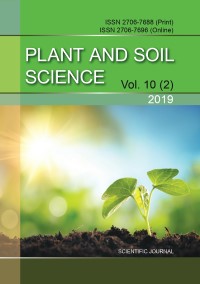Influence of weather factors on growth and development of sunflower hybrids
DOI:
https://doi.org/10.31548/agr2019.02.005Keywords:
sunflower, sowing time, row spacing, hybrids, productive moisture, water consumption ratioAbstract
Results of research, aimed at studying effect of various sowing regulations on productivity formation of sowings of investigated sunflower hybrids are presented. Studies were conducted during 2014-2016 in conditions of the Steppe of Ukraine on typical low-humus chernozems.
Task o research was to identify influence of such agrotechnical methods as time of sowing and width between rows, productive moisture in a meter-thick layer of soil, water consumption by plants of studied hybrids on formation 1 ton of dry matter and 1 ton of seeds.
In result of research was found that reserves of productive moisture at period of sowing were determined, both by sowing dates and weather features of the year of research. More provided by moisture, regardless of sowing time, was 2015, with indicators that were: early sowing time - 146.0 mm, recommended - 134.0 mm, late - 132.0 mm. A close correlation was established between yield and reserves of productive moisture in a meter-long layer of soil at sowing period with a correlation coefficient r = 0.89.
The level of total water consumption was determined by moisture conditions before sowing and during the growing season of sunflower and amounted 2977-3893 m³/ha in 2014, 2500-2737 m³/ha in 2015, and 2798-4259 m³/ha in 2016. On average, over the years of research, hybrids differed a little by the total water consumption. On average, over the years of research, sunflower hybrids spent on formation 1 ton of dry matter from 424 to 705 m3/t of water. Clear dependencies in obtained results were not revealed either for influence of sowing dates, or for influence of width between rows.References
Adamenko, T. (2005). Perspektyvy vyrobnytstva soniashnyku v Ukraini v umovakh zminy klimatu [Prospects for sunflower production in Ukraine in conditions of climate change]. Agronomist, 1, 102—103.
Vasylev, D. S. (1990). Podsolnechnyk [Sunflower]. M. : Ahropromyzdat, 174.
Gorbatyuk, E. M., Garbar, L. A. (2017). Osoblyvosti formuvannia produktyvnosti posiviv soniashnyku [Features of formation of productivity of sunflower seeds]. Journal of the Poltava State Agrarian Academy [Journal of the Poltava State Agrarian Academy], 1–2, 24–27.
Overchenko, B. (2001). Pryrodni resursy ta urozhai soniashnyku v Ukraini. [Natural resources and sunflower harvest in Ukraine]. Offer, 4, 39–40.
Nykytchyn D. Y. (1993). Podsolnechnyk [Sunflower]. Kyiv: Urozhai, 192.
Anashchenko, A. V. (1975). Reaktsyia rastenyi podsolnechnyka na yzmenenye uslovyi vlahoobespechennosty v raznыe etapi ontoheneza [The reaction of sunflower plants to changes in moisture supply conditions at different stages of ontogenesis]. Questions of physiology: Sat. scientific works, Krasnodar, 77–82.
Ushkarenko, V O., Laze, r P. N., Sy`dorenko, V. P., &Kaplin, O. O. (2005). Vplyv osnovnoho obrobitku gruntu, mineralnykh dobryv, shyryny mizhriaddia ta hustoty stoiannia roslyn na urozhai soniashnyku v piznomu pisliaukisnomu posivi [Influence of basic tillage, mineral fertilizers, row spacing and plant density on sunflower crop in late post-crop sowing]. Taurian Scientific Journal, 40, 3–11.
Kurash, O. V. (2002). Zavysymost urozhainosty podsolnechnyka ot vlazhnosty pochvi y predshestvennykov [The dependence of the yield of sunflower from soil moisture and predecessors]. Grain farming, 1, 25–26.
Kraevskiy, A. N., Karpenko, A. A., &Pershin, A. F. (2003). Tehnologiya promyishlennogo semenovodstva podsolnechnika i kukuruzyi na vostoke Ukrainyi: prakticheskoe rukovodstvo [Technology of industrial seed-grower of sunflower and corn on east of Ukraine : practical guidance]. Lugansk, 43.
Dospekhov, B. A. (1985). Metodyka polevoho opыta [Field experience]. Ahroproyzdat, 351.
Downloads
Published
Issue
Section
License
Relationship between right holders and users shall be governed by the terms of the license Creative Commons Attribution – non-commercial – Distribution On Same Conditions 4.0 international (CC BY-NC-SA 4.0):https://creativecommons.org/licenses/by-nc-sa/4.0/deed.uk
Authors who publish with this journal agree to the following terms:
- Authors retain copyright and grant the journal right of first publication with the work simultaneously licensed under a Creative Commons Attribution License that allows others to share the work with an acknowledgement of the work's authorship and initial publication in this journal.
- Authors are able to enter into separate, additional contractual arrangements for the non-exclusive distribution of the journal's published version of the work (e.g., post it to an institutional repository or publish it in a book), with an acknowledgement of its initial publication in this journal.
- Authors are permitted and encouraged to post their work online (e.g., in institutional repositories or on their website) prior to and during the submission process, as it can lead to productive exchanges, as well as earlier and greater citation of published work (See The Effect of Open Access).

